Abstract
In Aspergillus nidulans, a fungus that possesses negligible, if any, levels of methylation in its genome, low concentrations of 5-azacytidine (5-AC) convert a high percentage of the cell population to fluffy phenotypic variants through a heritable modification of a single nuclear gene (M. Tamame, F. Antequera, J. R. Villanueva, and T. Santos, Mol. Cell. Biol. 3:2287-2297, 1983). This new 5-AC-altered locus, designated here fluF1, was mapped as the closest marker to the centromere that has been identified so far on the right arm of chromosome VIII. Of all mutagens tested, only 5-AC induced the fluffy phenotype with a significant frequency. Furthermore, we determined that the wild-type, dominant allele of the fluF gene was primarily accessible to modification by 5-AC at the initial stages of fungal vegetative growth. These results indicated that 5-AC does not act through random mutagenic action but, rather, that fluF constitutes a specific target for this drug during a well-defined period of fungal development. Alteration of fluF by 5-AC resulted in a dramatic modification of the developmental program of A. nidulans. The resulting fluffy clones were characterized by massive, uncontrolled proliferation of undifferentiated hyphae, a drastic delay in the onset of asexual differentiation (conidiation), and colonies with an invasive nature. These features are reminiscent of the malignant properties of tumor cells. We propose that the locus fluF plays a primary role in the control of cell proliferation in A. nidulans and that its alteration by 5-AC produces pleiotropic modifications of the developmental program of this fungus.
Full text
PDF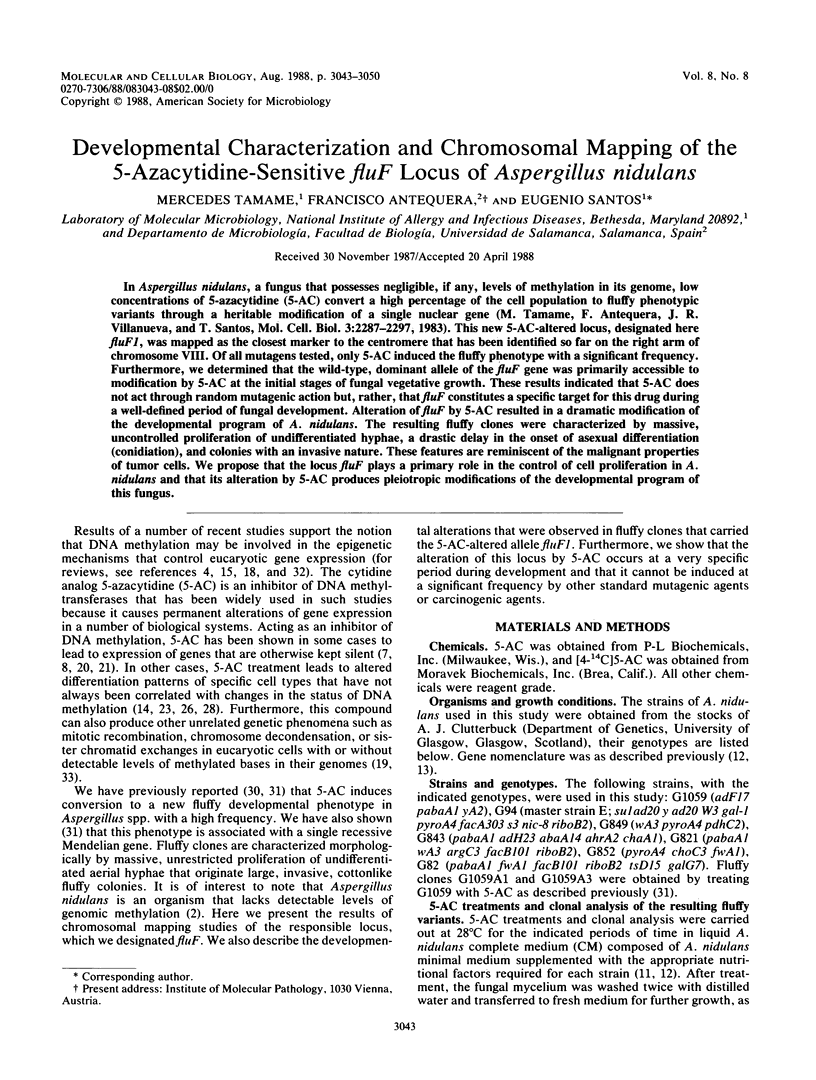
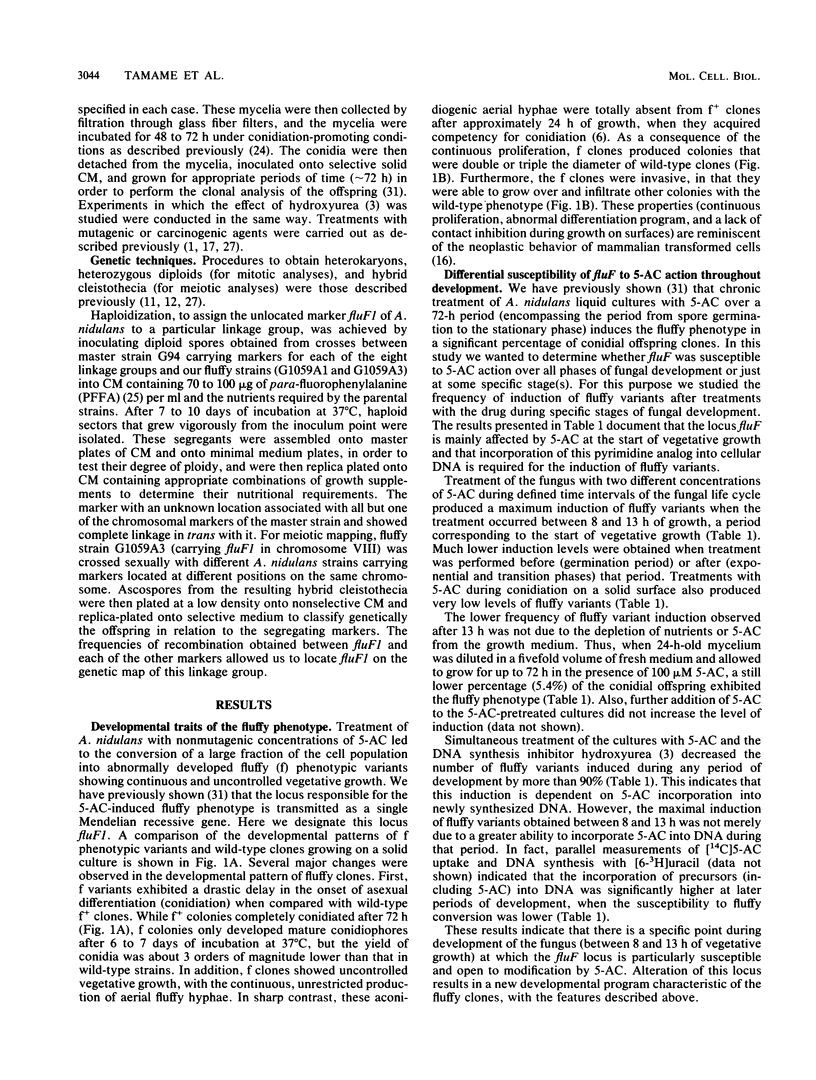
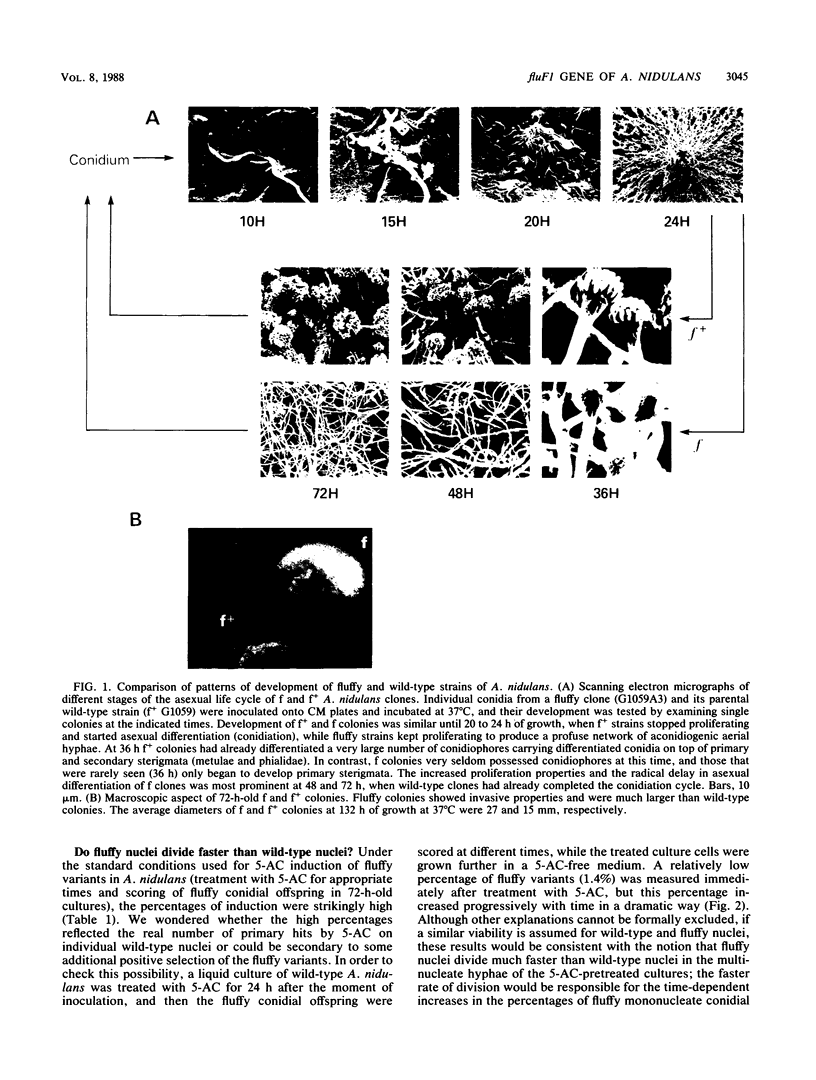
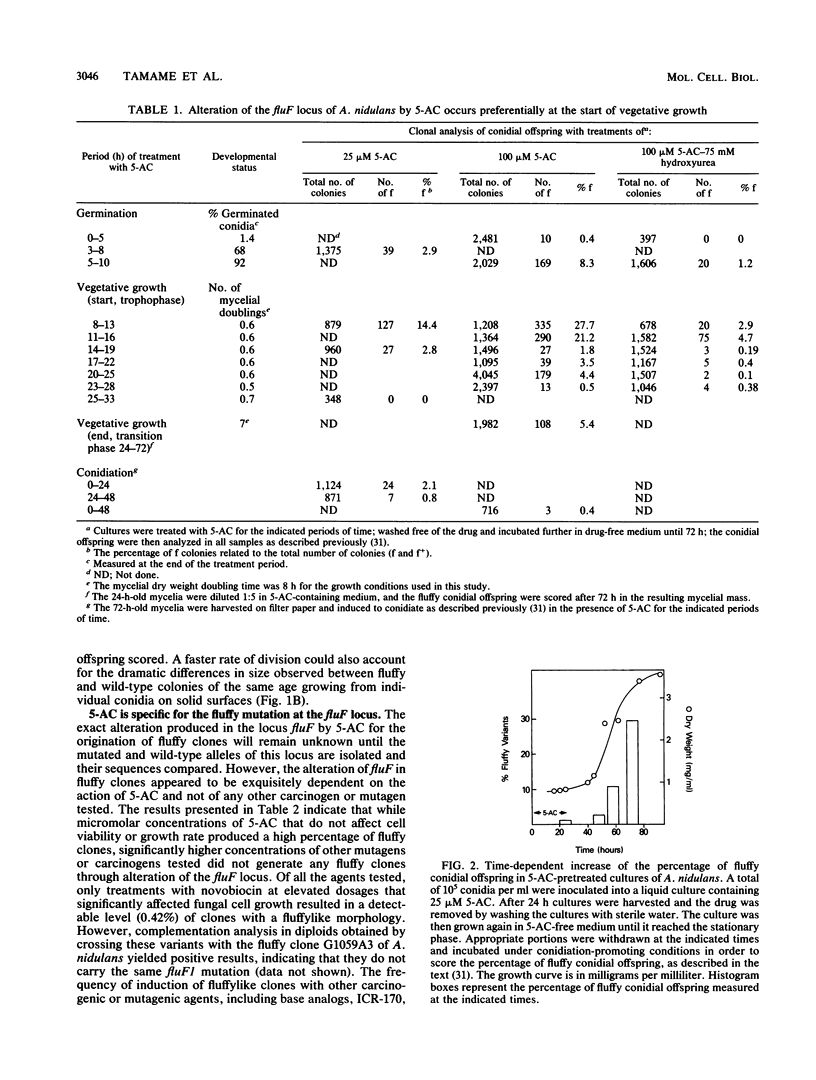
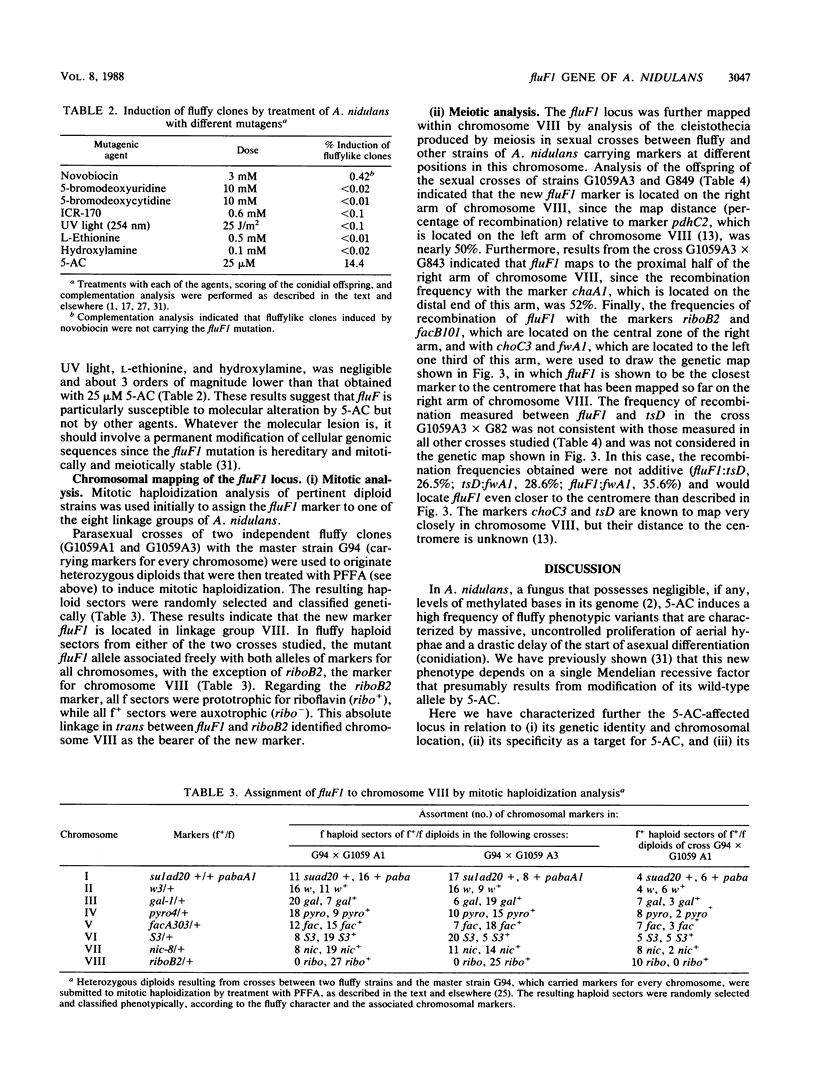
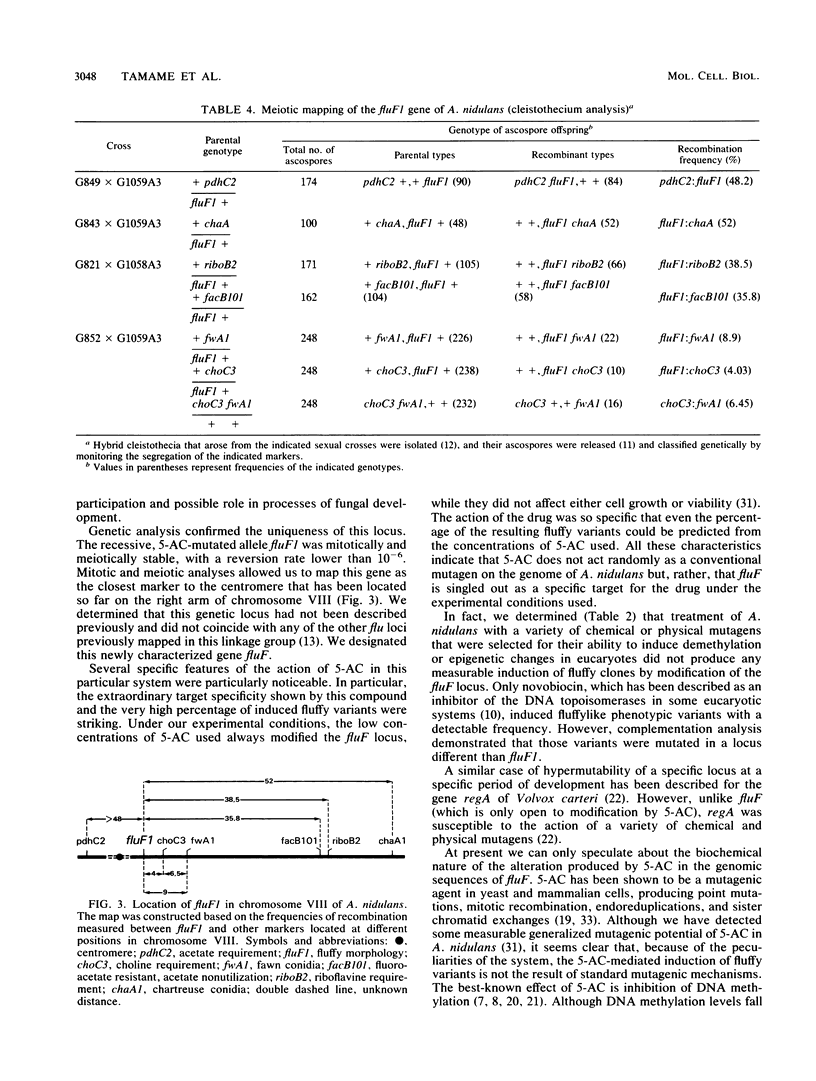
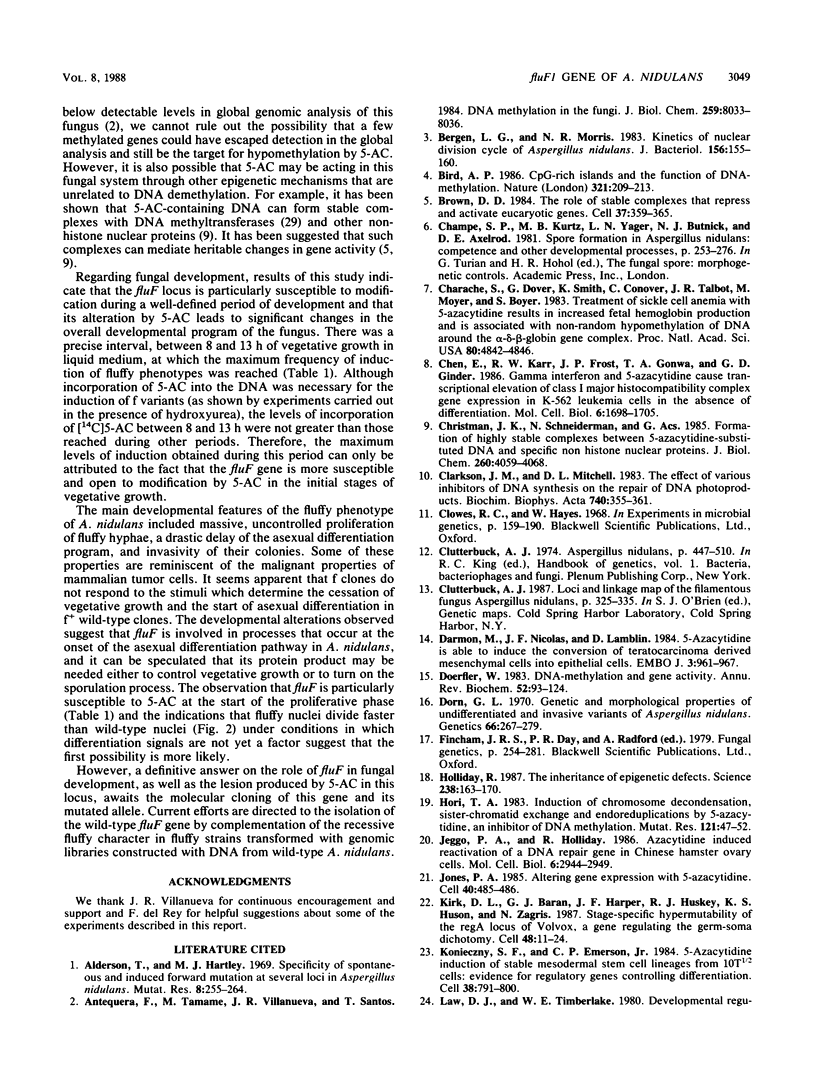
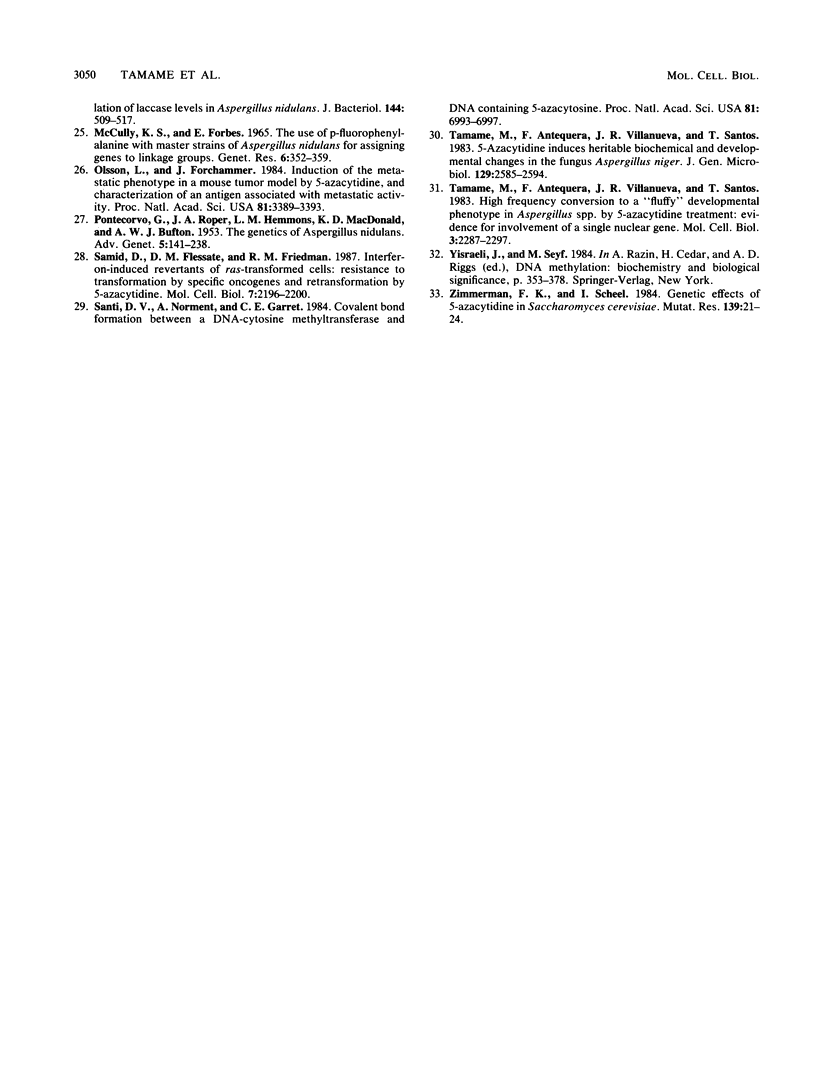
Images in this article
Selected References
These references are in PubMed. This may not be the complete list of references from this article.
- Alderson T., Hartley M. J. Specificity for spontaneous and induced forward mutation at several gene loci in Aspergillus nidulans. Mutat Res. 1969 Sep-Oct;8(2):255–264. doi: 10.1016/0027-5107(69)90005-0. [DOI] [PubMed] [Google Scholar]
- Antequera F., Tamame M., Villanueva J. R., Santos T. DNA methylation in the fungi. J Biol Chem. 1984 Jul 10;259(13):8033–8036. [PubMed] [Google Scholar]
- Bergen L. G., Morris N. R. Kinetics of the nuclear division cycle of Aspergillus nidulans. J Bacteriol. 1983 Oct;156(1):155–160. doi: 10.1128/jb.156.1.155-160.1983. [DOI] [PMC free article] [PubMed] [Google Scholar]
- Bird A. P. CpG-rich islands and the function of DNA methylation. Nature. 1986 May 15;321(6067):209–213. doi: 10.1038/321209a0. [DOI] [PubMed] [Google Scholar]
- Brown D. D. The role of stable complexes that repress and activate eucaryotic genes. Cell. 1984 Jun;37(2):359–365. doi: 10.1016/0092-8674(84)90366-0. [DOI] [PubMed] [Google Scholar]
- Charache S., Dover G., Smith K., Talbot C. C., Jr, Moyer M., Boyer S. Treatment of sickle cell anemia with 5-azacytidine results in increased fetal hemoglobin production and is associated with nonrandom hypomethylation of DNA around the gamma-delta-beta-globin gene complex. Proc Natl Acad Sci U S A. 1983 Aug;80(15):4842–4846. doi: 10.1073/pnas.80.15.4842. [DOI] [PMC free article] [PubMed] [Google Scholar]
- Chen E., Karr R. W., Frost J. P., Gonwa T. A., Ginder G. D. Gamma interferon and 5-azacytidine cause transcriptional elevation of class I major histocompatibility complex gene expression in K562 leukemia cells in the absence of differentiation. Mol Cell Biol. 1986 May;6(5):1698–1705. doi: 10.1128/mcb.6.5.1698. [DOI] [PMC free article] [PubMed] [Google Scholar]
- Christman J. K., Schneiderman N., Acs G. Formation of highly stable complexes between 5-azacytosine-substituted DNA and specific non-histone nuclear proteins. Implications for 5-azacytidine-mediated effects on DNA methylation and gene expression. J Biol Chem. 1985 Apr 10;260(7):4059–4068. [PubMed] [Google Scholar]
- Clarkson J. M., Mitchell D. L. The effect of various inhibitors of DNA synthesis on the repair of DNA photoproducts. Biochim Biophys Acta. 1983 Sep 9;740(4):355–361. doi: 10.1016/0167-4781(83)90082-9. [DOI] [PubMed] [Google Scholar]
- Darmon M., Nicolas J. F., Lamblin D. 5-Azacytidine is able to induce the conversion of teratocarcinoma-derived mesenchymal cells into epithelia cells. EMBO J. 1984 May;3(5):961–967. doi: 10.1002/j.1460-2075.1984.tb01914.x. [DOI] [PMC free article] [PubMed] [Google Scholar]
- Doerfler W. DNA methylation and gene activity. Annu Rev Biochem. 1983;52:93–124. doi: 10.1146/annurev.bi.52.070183.000521. [DOI] [PubMed] [Google Scholar]
- Dorn G. L. Genetic and morphological properties of undifferentiated and invasive variants of Aspergillus nidulans. Genetics. 1970 Oct;66(2):267–279. doi: 10.1093/genetics/66.2.267. [DOI] [PMC free article] [PubMed] [Google Scholar]
- Holliday R. The inheritance of epigenetic defects. Science. 1987 Oct 9;238(4824):163–170. doi: 10.1126/science.3310230. [DOI] [PubMed] [Google Scholar]
- Hori T. A. Induction of chromosome decondensation, sister-chromatid exchanges and endoreduplications by 5-azacytidine, an inhibitor of DNA methylation. Mutat Res. 1983 Jul;121(1):47–52. doi: 10.1016/0165-7992(83)90085-4. [DOI] [PubMed] [Google Scholar]
- Jeggo P. A., Holliday R. Azacytidine-induced reactivation of a DNA repair gene in Chinese hamster ovary cells. Mol Cell Biol. 1986 Aug;6(8):2944–2949. doi: 10.1128/mcb.6.8.2944. [DOI] [PMC free article] [PubMed] [Google Scholar]
- Jones P. A. Altering gene expression with 5-azacytidine. Cell. 1985 Mar;40(3):485–486. doi: 10.1016/0092-8674(85)90192-8. [DOI] [PubMed] [Google Scholar]
- Kirk D. L., Baran G. J., Harper J. F., Huskey R. J., Huson K. S., Zagris N. Stage-specific hypermutability of the regA locus of Volvox, a gene regulating the germ-soma dichotomy. Cell. 1987 Jan 16;48(1):11–24. doi: 10.1016/0092-8674(87)90351-5. [DOI] [PubMed] [Google Scholar]
- Konieczny S. F., Emerson C. P., Jr 5-Azacytidine induction of stable mesodermal stem cell lineages from 10T1/2 cells: evidence for regulatory genes controlling determination. Cell. 1984 Oct;38(3):791–800. doi: 10.1016/0092-8674(84)90274-5. [DOI] [PubMed] [Google Scholar]
- McCully K. S., Forbes E. The use of p-fluorophenylalanine with 'master strains' of Aspergillus nidulans for assigning genes to linkage groups. Genet Res. 1965 Nov;6(3):352–359. doi: 10.1017/s0016672300004249. [DOI] [PubMed] [Google Scholar]
- Olsson L., Forchhammer J. Induction of the metastatic phenotype in a mouse tumor model by 5-azacytidine, and characterization of an antigen associated with metastatic activity. Proc Natl Acad Sci U S A. 1984 Jun;81(11):3389–3393. doi: 10.1073/pnas.81.11.3389. [DOI] [PMC free article] [PubMed] [Google Scholar]
- PONTECORVO G., ROPER J. A., HEMMONS L. M., MACDONALD K. D., BUFTON A. W. J. The genetics of Aspergillus nidulans. Adv Genet. 1953;5:141–238. doi: 10.1016/s0065-2660(08)60408-3. [DOI] [PubMed] [Google Scholar]
- Samid D., Flessate D. M., Friedman R. M. Interferon-induced revertants of ras-transformed cells: resistance to transformation by specific oncogenes and retransformation by 5-azacytidine. Mol Cell Biol. 1987 Jun;7(6):2196–2200. doi: 10.1128/mcb.7.6.2196. [DOI] [PMC free article] [PubMed] [Google Scholar]
- Santi D. V., Norment A., Garrett C. E. Covalent bond formation between a DNA-cytosine methyltransferase and DNA containing 5-azacytosine. Proc Natl Acad Sci U S A. 1984 Nov;81(22):6993–6997. doi: 10.1073/pnas.81.22.6993. [DOI] [PMC free article] [PubMed] [Google Scholar]
- Tamame M., Antequera F., Villanueva J. R., Santos T. High-frequency conversion to a "fluffy" developmental phenotype in Aspergillus spp. by 5-azacytidine treatment: evidence for involvement of a single nuclear gene. Mol Cell Biol. 1983 Dec;3(12):2287–2297. doi: 10.1128/mcb.3.12.2287. [DOI] [PMC free article] [PubMed] [Google Scholar]
- Zimmermann F. K., Scheel I. Genetic effects of 5-azacytidine in Saccharomyces cerevisiae. Mutat Res. 1984 Jan;139(1):21–24. doi: 10.1016/0165-7992(84)90116-7. [DOI] [PubMed] [Google Scholar]



